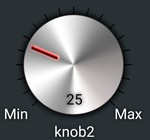|
| | BindKnob (const char *cstr) |
| | Constructs a BindKnob with a custom label.
|
| |
| | BindKnob () |
| | Constructs a BindKnob with a default label.
|
| |
| void | setLabel (const char *cstr) |
| | Sets the label text for the knob.
|
| |
|
void | setlabel (const char *cstr) |
| |
| void | setCallback (void(*callback)(int16_t)) |
| | Set the Callback function for the knob.
|
| |
|
void | invokeCallback (int16_t valueIn) |
| |
| uint16_t | getBytes (uint8_t *out) override |
| | Retrieves the bytes representing the knob for synchronization.
|
| |
The BindKnob class represents a knob UI element for use with BindCanvas.

BindKnob
BindKnob is a class that defines a knob UI element that can be used within BindCanvas-based applications. It inherits from the BindView class and provides functionality to create and customize knobs, including setting labels, positions, dimensions, value ranges, and current values.
- Note
- Possible cmdId values for a BindView and corresponding effects:
- BIND_ADD_OR_REFRESH_CMD: Adds the object to the canvas (screen) or refreshes the existing one.
- BIND_DATA_ONLY_CMD: Refreshes the existing object without moving or resizing; updates data, such as text.
- BIND_REMOVE_CMD: Removes the object from the canvas (screen).
- BIND_DISABLE_CMD: Disables the object.
- BIND_ENABLE_CMD: Enables the object.
- BIND_HIDE_CMD: Hides the object.
- BIND_VISIBLE_CMD: Restores the object's visibility.
Knobs created with BindKnob can be synchronized with BindCanvas through the Bind framework, allowing interactive user interfaces to be built for various applications.
- Note
- To use BindKnob effectively, you can set various properties such as the label, position, dimensions, value range (minimum and maximum), and the current knob value.

 Public Attributes inherited from BindView
Public Attributes inherited from BindView